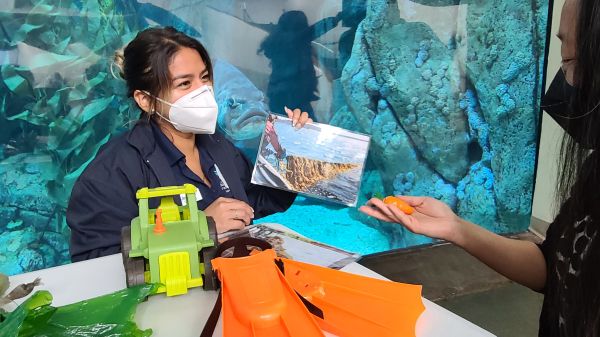Ocean Farmers: Learning Together Through Play

eeBLUE: Harvest Stories
This post was written by Emily Yam, Director of Learning and Public Engagement at the Aquarium of the Pacific.
Project partners include the Aquarium of the Pacific, USC Sea Grant, and Holdfast Aquaculture.
Sunlight pours in through a 28-foot tall window, showing California’s ocean backyard—a kelp forest habitat—at the Aquarium of the Pacific. Just to the right of the exhibit is something noticeably smaller than the 20-foot strands of giant kelp: it’s a short table, covered with toys. A little kid is combing through toy vegetables, a tiny diver’s mask, shells, and pieces of artificial seaweed. They put a tiny, plastic carrot up to their mouth and pretend to chomp on it.
“Where do you think the carrot goes, in the pile with the tractor, or the pile with the boat?” asks an educator seated on the floor. The little kid gleefully stuffs the carrot into the driver’s seat of the tractor. “Land farm!” they exclaim. They pick up a large oyster shell and pretend to chomp on it, too, and everyone laughs. “Ocean farm,” they say, as they stack the shell onto the toy boat.
This playful interaction was one example of Ocean Farmers, a collaborative project underway at the Aquarium of the Pacific. With support from the eeBLUE program, the Aquarium has partnered with colleagues at USC Sea Grant and Holdfast Aquaculture to develop and test a new series of activities that encourage young learners and their families to learn about ocean farming through play. Learners are introduced to marine aquaculture, or the cultivation of organisms found in the ocean, including finfish, shellfish (oysters, clams, lobsters), and algae or seaweed. Farming in the ocean is important because it is one way we can have sustainable food systems today and into the future.
Building Community
Ocean Farmers is a new, cross-sector, regional partnership that leverages individual institutional strengths in order to elevate our shared goal in aquaculture education. We meet monthly to discuss a variety of topics, ranging from recent publications in aquaculture, and message testing results conducted by the Aquarium of the Pacific’s Seafood for the Future office, to reflections from educators deploying the activity. Holdfast Aquaculture also hosted an Ocean Farmers network field trip so that partners could see a land-based recirculating aquaculture operation in action.
"We at Holdfast see education and outreach as part of our mission to support a growing sustainable Aquaculture industry in Southern California, so it's been incredibly rewarding to partner with folks from the AOP and USC Sea Grant who also embody this mission and connect us to an audience we typically don't reach," Diane Kim, CEO of Holdfast Aquaculture.
Playtime for Littles, Learning for Professionals
In addition to building collaborative partnerships, Ocean Farmers also provides new programming to Aquarium visitors. What makes Ocean Farmers distinctive is its heavy focus on play objects and settings made for young learners. “[Ocean Farmers] looks like it was made just for them,” noted educator Caitlyn, commenting on the short table covered with colorful toys and pictures.
Aquarium educators tested a sorting activity where learners were encouraged to play with objects, and then sort them into meaningful groups. Some learners were prompted to sort into land or ocean farms, while others were encouraged to define the groupings themselves. In the pilot phase, educators collected data from 164 interactions, reaching nearly 550 participants. Interactions (conversation and playtime) lasted more than four minutes on average.
Ocean Farmers has provided a wonderful opportunity to develop evaluative thinking and aquaculture literacy among education staff, as well. Sorting activities were facilitated by a full range of educators, from entry-level interpreters with only a few weeks’ experience, to managers with decades of experience. During the sorting activity, educators recorded observable behaviors associated with playing, sorting, talking, and other social interactions.
This observation instrument was developed by participating educators through iterative testing and discussion. Information from these instruments was also transcribed by the same educators, who workshopped through their reflections to develop a second Ocean Farmers activity and instrument to be deployed in the Summer of 2022.
Looking Ahead
Ocean Farmers has been a catalyst of activity across the network of partners. The sorting activity has provided data for developing activities that could be adapted for classroom programs and digital interactives. We’re also planning to continue our collaborations. Ocean Farmers partners are currently discussing opportunities to develop teacher professional development, as well as undergraduate courses and field trips.
Through the NOAA-NAAEE Collaborative Aquaculture Literacy mini-grants program, NAAEE supports partnerships sharing the mutual aquaculture literacy goals of the National Oceanic and Atmospheric Administration’s (NOAA) Office of Education, National Marine Fisheries Service (NMFS), and National Sea Grant Office. These mini-grants provide informal learning institutions (e.g., aquariums), aquaculture industry (e.g., shellfish, finfish, seaweed farmers), and NOAA partners with support for the co-development of innovative educational experiences that explore aquaculture topics and support the engagement and advancement of public aquaculture literacy.


